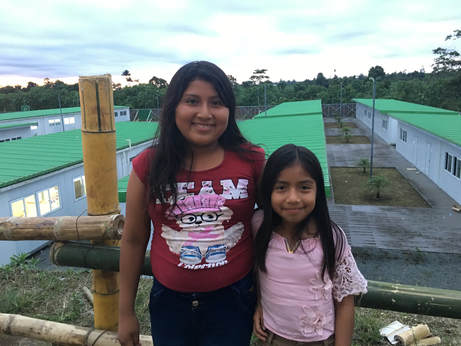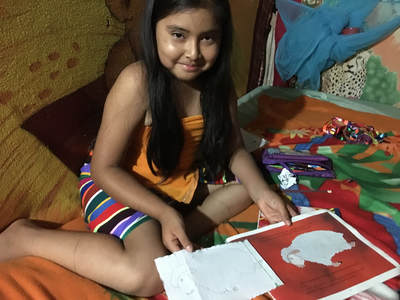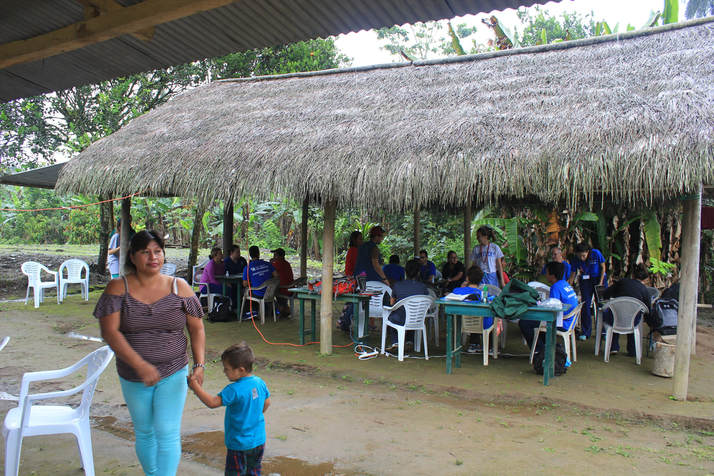 Sunday evening I was invited to go with Christina, Milena and Yosenka to the church. It was a short walk, which reinforced the notion that the central part of Bua is basically Christina’s house. Church turned out to actually be Sunday School, with about 50 kids from the age of seven through their early teens. I made several new friends, all of whom gave me flowers they picked after the lesson was over. It was really fun to try and follow the lesson as well as whisper with the little girls in the back row who were very interested in my presence. I was also given homework for next Sunday, which I dutifully started and was surprised to discover part of the lesson is written in a language other than Spanish. I asked Yosenka about it and she said it’s the language of the Tsa’chila, which made sense. When I visited Santo Domingo I’d noticed some of the signs in the Tsa’chila government building weren’t in Spanish and whenever Yosenka’s grandmother speaks to the cats and dogs, I could tell she wasn’t using Spanish. So I knew there was another language involved, but I didn’t know if it was wide spread or commonly spoken until I asked the girls. They said their grandparents and father speak the Tsa’chila language really well. They also said they speak it. When I continued to ask, they said they prefer Tsa’chila over Spanish, and so do most of the people living in Bua (according to data from the Medical Clinic that I’ll get to later in this post). Getting back to the Church, it was also interesting to think about the implications of the Catholic Church translating the messages from Spanish into the indigenous language – which is exactly how Catholicism spread hundreds of years ago. On Monday morning I followed Yosenka to school. She and I had talked about it, but I hadn’t gotten the chance to speak to her mom about it until Monday morning. I assumed Yosenka would have mentioned it, which was my bad, since she hadn’t. But her mom fed me breakfast and sent me off to the school alone since I was several minutes behind when class was supposed to have started. As I was walking over, I thought ‘the worst that can happen is I get kicked out of an elementary school.’ I arrived and it took me four tries out of four to locate the correct classroom. I ended up having to ask three of the teachers, only to have them be clueless and have the kids point to the correct classroom, before I located Yosenka. A brief conversation in Spanish with her surprised teacher ensued and I could tell something was up, but didn’t understand enough of what he was saying in rapid Spanish to try and figure out what it was. Also, since he didn’t seem overly worried about it and the kids accepted my presence, I let it go. For the next hour or so I followed the little kids around the room as they showed off homework projects and started working on a new project in groups. They were all requesting that I draw rabbits and trees on their new project – a group drawing exercise as far as I could tell. At around nine, another man arrived and started to talk to me in a new bout of rapid Spanish. At which point I did finally pick up on what was wrong. Basically, I hadn’t sought permission from the principal or school director to be there (which again, I hadn’t known I needed, but my bad). I apologized and said ‘yes’ a bunch of times, and then he left. The children had all gone quiet and were very subdued but since no one said anything to me or seemed to expect me to leave, I continued to sit quietly and observe the children color. About fifteen minutes later the teacher came back over to me and asked me why I hadn’t spoken to the director. I tried to explain that I hadn’t known and I was sorry, at which point he also backed off. I didn’t really know what to do at that point. I didn’t really want to leave, but was beginning to think that’s what I needed to do, but at the same time no one seemed to expect me to leave or had told or asked me to go. Another five or ten minutes passed and the teacher finally pulled Yosenka aside and I tried to hear what he was saying but didn’t catch much of it. She came back over she was very quiet and I asked if she was okay. She said yes and then quietly explained that I needed to go back to the house. I nodded and smiled, hoping I hadn’t gotten her into too much trouble, said goodbye to the teacher and class and dipped out. When I got back to the house I explained to Christina that I wasn’t sure exactly what had happened, but I thought it had to do with a lack of communication between me and the school director. I told her I didn’t mind/was worried about it, but that I didn’t want to have gotten Yosenka into trouble. Christina seemed to brush the entire thing off so I guess I’ll wait until Yosenka comes home to see if it’s ok. Although, Christina might have brushed the entire thing off because there were eighty people sitting in her front yard. Either medical personal or people waiting to be seen. I’d known they were going to have a clinic on Monday, but I’d honestly expected one or two doctors from Santo Domingo and that it wouldn’t be very big. I was wrong. It was big. The number of doctors and other medical personal outweighed the people waiting, which is probably a good thing for the patients. I asked around and there were about 76 medical staff at Christina’s house, which was about half of the traveling brigade. And by the end of the day, 83 patients had been seen. The medical staff were everywhere, inside the side part of the house, under both outer awnings, and even stationed under the awning directly in front of Christina’s door. It was raining, so that might have been part of why they were stationed how they were, but something tells me that it is fairly normal for them to be set up this way.  The traveling brigade is part of the University of Kentucky and Ecuadorian students who acted as translators. They take part in this brigade every few months and visit the same Tsa’chila communities year after year. Several of the medical team had taken part in the brigade before and said the best part was seeing some of the same people again. The day closed with a cultural presentation that was fascinating, not only because it was interesting, but also to watch the reactions of the ‘volunt-tourists.’ It was particularly fun to watch the medical team leave in their tour bus and spent the rest of the evening with several of the local girls learning phrases from the Tsa’chila language. Next: I interview a new friend's abuela about her knowledge of indigenous plants as medicine.
Wendy
5/15/2018 12:55:24 pm
What are the green and white buildings behind the girls in the first picture?
Reply
Your comment will be posted after it is approved.
Leave a Reply. |
AuthorMy name is Hunter and this the blog of my worldwide adventures. The purpose of this blog is to show that you can be a traveler, not just a tourist. Archives
March 2019
Tags
All
|
Proudly powered by Weebly
